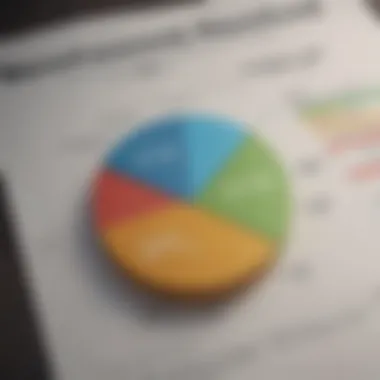Analyzing Mortgage Refinance Interest Rate Trends


Intro
In the ever-changing landscape of finance, mortgage refinance interest rates hold a critical position that can significantly affect both homeowners and investors. Understanding how these rates fluctuate is not merely an academic exercise; it has practical implications for anyone thinking about their next financial move. As the economy waxes and wanes and policies shift, the trends in these interest rates provide a lens through which one can gauge the health of the broader financial market.
Given this context, this article aims to unravel the complexities behind mortgage refinance interest rates, providing a well-rounded analysis that helps demystify the subject. Homeowners, or would-be ones, can benefit from a keen insight into historical data, the influences behind rate changes, and predictions that may shape their refinancing decisions in the near future.
In short, whether you are looking to save a few bucks on your monthly payment or gauge the overall sentiment of the mortgage market, knowing the trends associated with interest rates is indispensable. Let's dive into the essential concepts that form the groundwork for our discussions.
Prologue to Mortgage Refinance Interest Rates
Understanding the intricate dance of mortgage refinance interest rates is crucial for both homeowners and investors alike. Without a firm grasp on these rates, individuals might find themselves caught in a web of financial jargon that could lead to costly missteps. In essence, refinancing a mortgage means replacing an existing loan with a new one, often with more favorable terms. This process can unlock potential savings, reduce monthly payments, and even allow homeowners to tap into their home equity for various financial uses.
Understanding Mortgage Refinancing
Mortgage refinancing can seem like a labyrinth for the uninitiated. However, it can be boiled down to a few key points. The primary objective of refinancing is to secure better loan conditions. When interest rates take a dive, homeowners often seize the chance to lower their monthly payments or even shorten their loan terms. It’s like catching a rising wave just at the right time.
Here are some essential aspects to consider:
- Lower Interest Rates: A major driver for refinancing is to obtain a lower interest rate than what is currently being paid. This reduction can lead to significant savings over the life of the loan.
- Changing Loan Terms: Homeowners may choose to extend or shorten their loan's duration, affecting the amount paid each month. For example, switching from a 30-year loan to a 15-year loan might increase monthly payments but saves on interest in the long run.
- Accessing Home Equity: Homeowners can cash in part of their equity to fund large purchases, such as renovations or education expenses. This practice often is referred to as a cash-out refinance.
Navigating these aspects can truly empower homeowners. Yet, while refinancing sounds appealing, it also demands a thorough evaluation of costs and benefits, ensuring that each decision aligns with individual financial goals.
Significance of Interest Rates in Refinancing
Interest rates play a pivotal role in the refinancing landscape. They can either be a friend or a foe. A deeper understanding of how these rates shift can be the difference between savvy financial decision-making and throwing money out the window.
- Market Dynamics: Interest rates are influenced by a variety of economic conditions. These include inflation, central bank policies, and overall market sentiments. When the Federal Reserve decides to cut rates, it often sends a ripple effect throughout the economy, making borrowing cheaper.
- Long-Term Investments: For homeowners, securing a lower interest rate not only reduces monthly repayments but also contributes to the overall reduction in total interest paid on the loan. Over time, even a fraction of a percent can amount to tremendous savings.
"Choosing the right moment to refinance can set you up for years of financial tranquility. Staying informed about the trends can be your best ally."
Historical Trends in Mortgage Refinance Rates
Understanding the historical trends in mortgage refinance rates is essential for any homeowner or investor looking to navigate the complexities of the financial market. These trends provide a lens through which one can understand past behaviors, which can help in predicting future movements and informing crucial refinancing decisions.
Historically, mortgage refinance rates have been influenced by a variety of factors including economic conditions, inflation, and market sentiment. By analyzing these trends over the decades, homeowners can not only strategize their own refinancing efforts better but also gauge when the best time to act might be. This insight can ultimately lead to significant financial savings.
Decade Overview of Refinancing Rates
Looking back through the years offers a rich narrative about how mortgage refinance rates have evolved. The 1980s saw some of the highest rates recorded, often surpassing 18%. Homeowners with fixed mortgages faced heavy heartache from high-interest payments. By the late 1990s, however, the rates began to dip significantly, making refinancing a more attractive option for many.
In the early 2000s, with rates hovering around 5%, a wave of homeowners took to refinancing, aiming to reduce monthly payments or consolidate debts. As the market wobbled after the 2008 financial crisis, rates plummeted to historical lows, enticing even more individuals to jump on the refinancing bandwagon.
To illustrate:
- 1980s: Interest rates peaked above 18%
- 1990s: Gradual decrease, stabilizing around 7-8%
- 2000s: Rates fell further, averaging around 5%
- Post-2008: Rates dipped to around 3-4%
This decade overview paints a vivid picture of how fluctuating rates can affect refinancing options for homeowners, establishing clear correlations between economic events and interest rate shifts.
Impact of Economic Crises
Economic crises have had a profound impact on mortgage refinance rates. Financial downturns often prompt central banks to adjust interest rates to stabilize economies. For instance, during the 2008 recession, the Federal Reserve took drastic measures to lower interest rates and stimulate the economy, resulting in lower mortgage refinance rates—many borrowers found themselves with the opportunity to refinance their mortgages at much more favorable terms than before.
Considering how these crises can influence rates further emphasizes the importance of a timely and informed approach to refinancing. Here are a few notable examples:
- Great Recession (2007-2009): Following the crash, interest rates fell sharply as the Fed reduced rates to near-zero levels.
- Pandemic (2020): A rapid drop in rates occurred again as economic instability led to unprecedented monetary policies aimed at supporting the economy.


"Economic turmoil often presents unique opportunities for savvy homeowners, enabling them to capitalize on lower interest rates, provided they act swiftly and judiciously."
In summary, the historical trends of mortgage refinance rates not only help in constructing a timeline of financial behavior but serve as a guide for future decision-making, making it critical for homeowners and investors alike. Understanding these patterns enhances one's ability to make informed choices and take prompt action in times of shifting economic landscapes.
Factors Influencing Mortgage Refinance Rates
Understanding the factors that steer mortgage refinance rates is paramount for anyone looking to navigate this complex landscape. Interest rates don’t operate in a vacuum; they’re affected by a medley of economic indicators, central bank policies, and market sentiments. Knowing these influences can significantly impact your refinancing decisions, potentially guiding you toward a more favorable financial outcome.
Economic Indicators
GDP Growth
GDP growth stands as a key indicator of economic health and directly correlates with mortgage refinance rates. Essentially, when the economy is thriving, people generally feel more secure financially, leading to greater demand for mortgage loans. In a booming economy, interest rates tend to creep up because lenders perceive less risk in lending.
A crucial characteristic of GDP growth is its ability to reflect overall economic vitality. If the GDP is on the rise, it implies a robust job market and increased consumer spending, which in turn can lead to higher refinancing rates. However, this growth isn’t without its drawbacks; it can also signal the potential for inflation, which often prompts central banks to hike interest rates.
In summary, GDP growth presents a double-edged sword in the refinancing landscape. While it can indicate a healthy economy, it also often results in elevated interest rates that may not be favorable for refinancing at that point in time.
Inflation Rates
Inflation directly impacts the purchasing power of consumers, and thus, it plays a pivotal role in shaping mortgage refinance rates. When inflation rises, the cost of goods and services escalates, leaving less disposable income for homeowners. Consequently, lenders may increase rates to offset this risk and maintain their profit margins.
The primary feature of inflation is that it tends to prompt a reaction from the central banks aimed at stabilizing the economy. Higher inflation rates usually lead to an increase in interest rates, which can make refinancing significantly more expensive.
In this regard, inflation acts as a warning sign for homeowners contemplating refinancing. If inflation is on an upswing, now may not be the best time to jump into a refinance.
Employment Figures
Employment figures serve as another telling sign of economic conditions and consumer confidence. High employment rates typically mean a more stable economy. As more folks earn wages, their confidence in long-term commitment—such as refinancing a mortgage—grows as well.
A standout quality of employment data is its ability to provide insight into labor market trends. A strong job market often means that people can afford to take on new loans or adjust existing ones. Conversely, if employment figures falter, lenders may tighten their belts, and refinance rates may rise due to perceived higher risks.
Therefore, current employment statistics are essential for anyone considering refinancing, as they reflect both economic stability and the general well-being of consumers.
Central Bank Policies
Interest Rate Adjustments
Central banks wield a hefty influence on mortgage refinance rates through their interest rate adjustments. When a central bank raises rates, it can send ripples through the mortgage market, typically increasing the rates lenders offer on refinances. The underlying principle here is straightforward: higher borrowing costs mean steeper rates for mortgages.
A hallmark of this mechanism is how central banks respond to inflationary pressures and economic growth. For instance, if inflation is heating up, a central bank may step in to raise interest rates to cool the economy, impacting refinancing rates negatively for consumers.
It’s essential to keep an eye on central bank announcements and economic forecasts, as they often have a direct line to rate offers you see from lenders.
Quantitative Easing
Quantitative easing is a relatively novel approach central banks have employed to influence economic conditions, and it holds considerable sway over mortgage refinance rates as well. Through this policy, central banks inject money into the economy by purchasing government securities. This influx of capital aims to lower interest rates, making borrowing cheaper.
What sets quantitative easing apart is its proactive nature. It seeks to catalyze economic growth, making it a tool of choice in times of economic stagnation. While it can lead to lower refinance rates, one must be mindful of potential long-term effects, particularly if inflation begins to rear its head again.
In this sense, while quantitative easing is favorable for refinancing in the short term, the long-term consequences merit caution.
Market Sentiment
Consumer Confidence


Consumer confidence plays a significant role in the movement of mortgage refinance rates. Essentially, when people feel secure about their financial future, they’re more likely to consider refinancing. A confident consumer base can drive demand for refinancing options, which sometimes pressures lenders to adjust rates.
A pivotal aspect of consumer confidence is its emotional underpinnings. Rising consumer confidence can signal a healthier economy, and with it, the likelihood of lower rates as lenders feel increased security over borrower reliability. Conversely, a dip in consumer confidence can lead to a tightening of lending standards, pushing refinance rates up.
Therefore, gauging consumer sentiment is crucial for potential refinancers, as it can serve as an early indicator of market conditions.
Investor Behavior
Investors’ behaviors in financial markets also have a bearing on mortgage refinance rates. When investors pull back from the mortgage-backed securities market, it can lead to higher rates for consumers who are looking to refinance. Investors are always on the lookout for better returns, and if they sense risks emerging in the market, they might steer clear from mortgage investments.
A central characteristic of investor behavior is its reflexive nature; they often react to economic signals, which can create a cascading effect on mortgage rates. If investors are upbeat about the economy, competition may keep refinance rates low. However, any adverse sentiment could lead to increased rates as lenders adjust to perceived risks.
In sum, paying attention to investor behavior not only helps in understanding economic conditions but also provides insights into potential fluctuations in refinance rates.
"Navigating the intricate network of factors that sway mortgage refinance rates can empower consumers to make informed decisions. It’s more than just numbers; it’s about understanding the financial landscape you operate within.”
Current Landscape of Mortgage Refinance Rates
Understanding the present state of mortgage refinance rates is crucial for homeowners pondering whether now is the right time to secure a lower interest rate or change their mortgage terms. Given the fluctuations in economic conditions and government policies, these rates can vary significantly over short periods. Thus, being informed about current trends, as well as how they stack up against historical data, can offer invaluable guidance in financial decision-making.
This section will delve into recent rate trends, highlighting the most relevant movements in the market, and conduct a comparative analysis with historical averages. Homeowners and investors alike will find that these insights can illuminate the broader economic context and personal financial implications of refinancing decisions.
Recent Rate Trends
In the past year, mortgage refinance rates have experienced notable fluctuations influenced by various economic factors. As of late 2023, rates have steadily shifted in response to inflationary pressures and Federal Reserve policies. Recently, the average rate for a 30-year fixed mortgage hovered around 7%, a significant jump from the rates seen during the pandemic when they dipped below 3%.
A closer look at recent movements reveals some important points:
- Post-Pandemic Adjustments: After the pandemic, rates climbed as the economy reopened and demand surged.
- Inflation Dynamics: Higher inflation has nudged the Federal Reserve to take measures to cool down the economy, which has raised interest rates.
- Market Reactions: Investor sentiment has been volatile, impacting mortgage-backed securities and thus refinance rates.
- Seasonal Variations: Historically, rates may decrease during winter months but can see upticks as the spring home buying season begins.
These characteristics make it clear that homeowners need to be diligent about monitoring interest rate charts and economic news to fully understand when it might be beneficial to refinance.
Comparative Analysis with Historic Averages
Looking at the current landscape in relation to historic averages provides further context to the trends. In the early 2000s, average rates floated around 6-7%. However, they reached a historical low in 2021, with several weeks showing averages below 3%. The current average of around 7% still reflects tight conditions compared to these lows, but one must also consider broader historical trends.
Some notable points of comparison are:
- Long-term Perspective: Over the past 50 years, mortgage rates have fluctuated between 3% and 18%, showcasing the variability influenced by economic cycles.
- Crisis Impacts: Past financial crises, like the 2008 housing market crash, witnessed rates dropping as low as 3.3% to stimulate recovery. Today’s rates, while higher, may also indicate a stabilizing market after the pandemic-induced volatility.
- Global Economic Influences: Changes in international markets can directly impact U.S. rates. For instance, additional geopolitical instability often leads to a flight to safety in U.S. treasuries, indirectly affecting mortgage rates.
In sum, comparing today’s refinance rates to historic averages allows homeowners to draw insights about potential timing for refinancing or locking in better terms in the future. The current landscape, while seemingly high compared to the recent past, still poses opportunities for those ready to take the plunge and navigate this dynamic market.
"A comprehensive understanding of mortgage refinance rates benefits financial decisions, fostering strategic movements in a changing economy."
Future Projections of Refinance Rates
Understanding the future of mortgage refinance interest rates can significantly impact the decisions made by homeowners and investors alike. It’s not just about the numbers; it’s about what those numbers mean for financial strategies in the coming years. Given the fluidity of the economic environment, having a bead on potential movements in refinance rates is crucial. Homeowners can decide whether to enter the market now, while investors can strategize on acquiring properties or refinancing existing ones.
The importance of analyzing future projections is multifaceted; it involves gauging economic forecasts, policy shifts, and broader market sentiment. A loan decision today might hinge on where interest rates are expected to head in the near term. Homeowners eager to lower their monthly payments or tap into home equity should carefully consider trends that could affect their refinancing timelines and choices.
Forecasting Techniques
Various forecasting techniques are used by experts to predict mortgage refinance rates. Some popular methods include:
- Statistical Models: Techniques that utilize historical data to identify trends and make projections based on past patterns.
- Econometric Analysis: A more complex approach that leverages economic theories and related data to project future rate movements.
- Technical Analysis: This method focuses on analyzing market data, primarily price movements, rather than underlying economic fundamentals to predict future trends.
- Sentiment Analysis: By examining social media trends and investor behavior, analysts can gauge market sentiment and its potential impact on refinance rates.


While no method is foolproof, combining several forecasting techniques often yields the best results. Importantly, these tools are limited by the unpredictability of factors such as sudden economic shifts or unexpected policy changes.
Expert Predictions
Expert predictions in the mortgage refinancing arena often provide a blend of insights, reflecting a range of opinions based on various analyses. For instance, some financial analysts anticipate that the Federal Reserve's approach to interest rates will play a significant role. If the Fed decides to hike rates due to inflation concerns, refinance rates might follow suit, making it less attractive for homeowners to refinance.
On the flip side, if economic indicators such as job growth remain steady, experts might argue for stabilization in rates, potentially encouraging refinancing activities. It’s important to digest these predictions with a grain of salt. According to multiple financial sources, the sentiments in the market can shift rapidly, leading to changes in expected refinance rates.
"In real estate, as in life, nothing is certain except uncertainty itself."
Refinancing Strategies in a Changing Rate Environment
Navigating the intricacies of mortgage refinancing in a fluctuating interest rate environment requires a keen understanding of timing and strategy. Homeowners and investors alike must grasp not only the current trends but also how these factors interplay with their financial situations. The significance of prudently adapting refinancing strategies lies not just in immediate savings but in long-term financial positioning.
When to Refinance
Identifying the optimal moment to refinance is akin to catching lightning in a bottle. There’s no universal answer, as circumstances widely differ from person to person. Factors often sway decisions, such as a change in life circumstances—like a new job, an increase in family size, or even fluctuating income.
Nevertheless, several common indicators suggest when refinancing might be in the cards:
- Interest Rate Drops: If rates dip significantly below your current mortgage rate, it’s usually a green light.
- Improved Credit Score: A year or two for your credit score to climb can open doors to better rates.
- Increased Home Value: If your home’s worth has jumped, you might pocket a better deal—improving your loan-to-value ratio can mean better opportunities.
Regard refinancing as a chess game. You have to anticipate moves: when the market shifts or personal finances change, you need to act decisively. Waiting too long can cost you, while hastiness might lead you to unfavorable terms.
Cost-Benefit Analysis of Refinancing
When approaching the idea of refinancing, conducting a cost-benefit analysis is critical. This involves weighing the potential savings against the costs incurred in the process.
Key costs to consider:
- Closing Costs: These can range from 2% to 5% of the loan amount, encompassing points, title fees, and other expenses. A higher loan amount means higher closing costs, so know what you’re getting into.
- Prepayment Penalties: Certain lenders enforce penalties if you pay off your mortgage too early. These fees can eat into any savings you might expect from refinancing.
- Loan Terms: If you’re extending the term of your mortgage when refinancing, you could end up paying more interest over time, negating initial savings.
On the flip side, it’s crucial to recognize the benefits:
- Lower Monthly Payments: If rates are favorable, your monthly outlay could decrease significantly, easing financial burdens.
- Access to Home Equity: With increased equity from house value appreciation, you can cash out and fund renovations or investments.
- Consolidate Debt: Refinancing could allow you to wrap other high-interest debts into your mortgage, ultimately saving you on interest payments.
Conducting a thorough cost-benefit analysis not only demystifies refinancing but empowers homeowners to take advantage of market conditions.
Epilogue
The conclusion of any discussion around mortgage refinance interest rates serves as a vital component of understanding the overall dynamics at play. In this article, we explored the historical trends, current landscapes, and predictive outlooks pertaining to refinancing. But why is the conclusion essential? It encapsulates myriad elements that can steer decisions for homeowners and investors alike.
Summary of Key Insights
To tie everything together, it's important to reflect on the central points we delved into. Here’s a brief recap:
- Historical Performance: Tracking how refinance rates have moved over the decades sheds light on patterns that might repeat or deviate in the future.
- Economic Influences: Various economic indicators — such as inflation or job data — present a backdrop that can either facilitate or stymie favorable refinancing opportunities.
- Central Bank Decisions: How interest rates are set by institutions like the Federal Reserve plays a crucial role in shaping the refinancing landscape. The delicate balance they manage can affect long-term borrowing costs for consumers.
- Market Sentiment: Understanding consumer confidence and investor behavior helps in gauging how likely individuals are to act on refinancing opportunities.
"In the world of finance, knowledge isn't just power; it's the currency that drives informed decision-making."
Each of these insights contributes to a more nuanced grasp of what refinancing entails in any given era. Moreover, they empower potential refinancers to make choices that align with their financial goals effectively.
Final Thoughts on Refinancing Decisions
Reflecting on refinancings decisions necessitates an awareness of both personal financial situations and the broader economic climate. It is essential to weigh all variables, including potential costs and benefits, to arrive at a sound resolution.
Considerations might include:
- Timing: Is now the right moment? Comparing current interest rates to historical averages can provide a clearer picture.
- Long-Term vs. Short-Term Benefits: Evaluating if a lower rate equals more savings long-term, or if the refinancing costs might outweigh these initial savings.
- Personal Financial Health: Are you in a strong position to refinance? Credit scores, current debt levels, and overall financial stability play huge roles.
In summary, making the right refinancing decision requires careful analysis of both the micro and macro factors impacting mortgage rates. Homeowners and investors must be proactive in seeking out information and analyzing trends to navigate this complex landscape. The insights provided in this analysis aim to guide you as you embark on or continue your refinancing journey.







